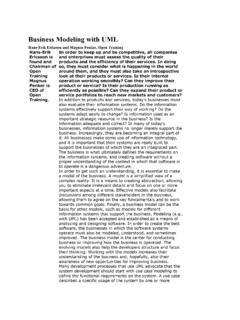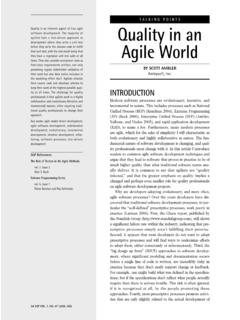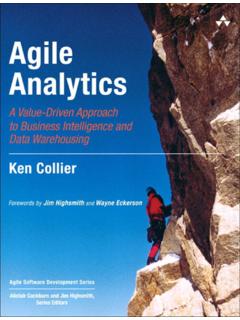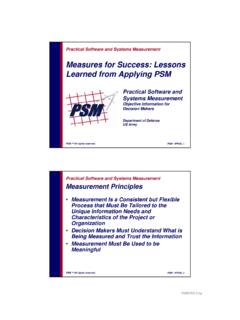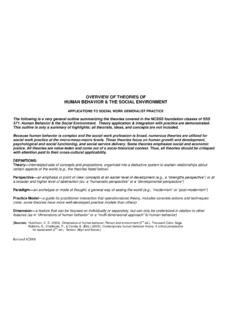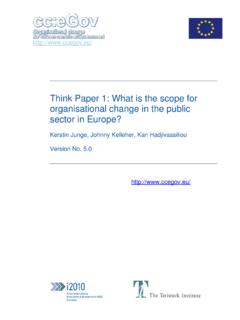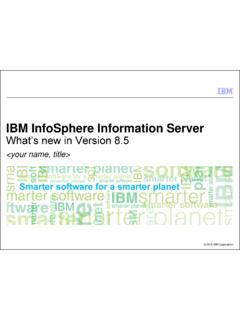Transcription of Use Case-Based Software Development - Haumer
1 Scenarios Part 2: Techniques Use Case-Based Software Development Use Case-Based Software Development Peter Haumer IBM rational Software Biography & Photograph: Dr. Peter Haumer is a Content Developer for the IBM rational Unified Process prod-uct platform. Currently, he is working as the content architect for the future genera-tions of IBM s integrated process architecture. Before joining the RUP team, he worked as a Senior Professional Services Consultant for IBM s rational Software Brand.
2 He assisted and coached customers to be successful with the rational Unified Process platform and rational tools performing on-site consulting and providing training courses. His areas of work include requirements management, object-oriented analysis and design for enterprise application architectures, as well as Soft-ware process implementation. He is also member of rational s steering committees for Model-Driven Development , Software Process Adoption, as well as Business Modelling, Requirements Management, and rational XDE education.
3 Before joining rational he worked in basic research in the areas of requirements engineering and flexible case tool architectures. Keywords: use cases , Requirements, Object-Orientation, Analysis, Design, UML, Model-Driven Development , rational Unified Process. Summary: Use case authors have the difficult task of writing their specifications for many differ-ent audiences. They have to balance language, content, and style of their use cases for the needs of non-technical as well as technical stakeholders.
4 While most chapters in this book focus on the non-technical stakeholders, such as customers and users, this chapter discusses the developer as another important audience of use cases . To be able to successfully write use cases that are also usable for this audience the System Analyst has to understand what the developers are actually going to do with the use cases . Knowing what information is required will improve the quality of the use cases for the Development team.
5 (The difficulty will still be, of course, to keep the balance for the other audiences to not to negate the main benefit of use cases : to facili-tate interdisciplinary communication of requirements.) 1 Scenarios Part 2: Techniques Use Case-Based Software Development I will outline in this chapter the role use cases play for Object-Oriented Analysis and Design (OOAD) as it is being described in the rational Unified Process (RUP 2003). I will begin by discussing the particular properties use cases possess that make them such an ideal tool for requirements management as well as guiding Software design.
6 I will define additional concepts that are also required to complement use cases for these tasks. Next, I will walk you through a core set of analysis and design activities, examining the role use cases play for these activities, using examples from a web based e-commerce application. Applicability: Projects with interdisciplinary team communication. Projects utilising object technology and modern design frameworks ( J2EE, .NET). Wide range of Software and systems-engineering projects in terms of scale from small web-based e-business applications via business process engineering projects to large-scale systems engineering projects (the latter two applying a use case flow-down between systems and sub-systems not discussed in this chapter; see (Cantor 2003) and (RUP SE 2003) for more details).
7 Key Features: Industry leading Software Development process. Iterative, risk, and use case -driven analysis and design methodology. Full traceability from requirements to analysis to design to code. Augments requirements with user experience modelling to improve communica-tion on requirements and designs. Facilitates predictable and repeatable iterative Development through analysis and design mechanism and trace-based impact assessment. Extensive tool support available (not discussed here).
8 Strengths: use cases present requirements in context improving communication within inter-disciplinary teams by focusing on delivering actor value and not technical detail. use cases relate to stakeholder goals which facilitate prioritisation and planning of iterative Development (implementing high priority and risky requirements first). RUP OOAD defines well-understood and scalable process of transforming re-quirements into Software solutions. RUP OOAD systematically established traceability as part of the primary activi-ties to support iterative Development as well as change impact-assessment and management.
9 Weaknesses: Reading and understanding use cases should be easy for any stakeholder. How-ever, modelling and writing use cases that they are easily understood as well as successfully used for analysis and design requires a well-trained system analyst and designer. As a result, experience is required to avoid typical pitfalls when adopting use cases and OOAD such as functional decomposition of use cases , over-analysis of use cases and analysis models, avoiding the right amount of details in use cases , mixing requirements and design decisions, not using the right amount of analysis mechanisms to abstract from design decisions in the right places.
10 Not enforcing design mechanisms in the teams to systematically incorporate design decisions that lead to repeatable and maintainable designs, etc. 2 Scenarios Part 2: Techniques Use Case-Based Software Development RUP OOAD also requires an architect with solid methodological as well as tech-nical understanding leading the design with experience, vision, and creativity. Technique and Worked Example: The Use case -Centred Requirements Framework I will start this chapter by listing and defining the key elements a designer needs to be provided with to do OOAD, the inputs to this discipline of Software engineering.
